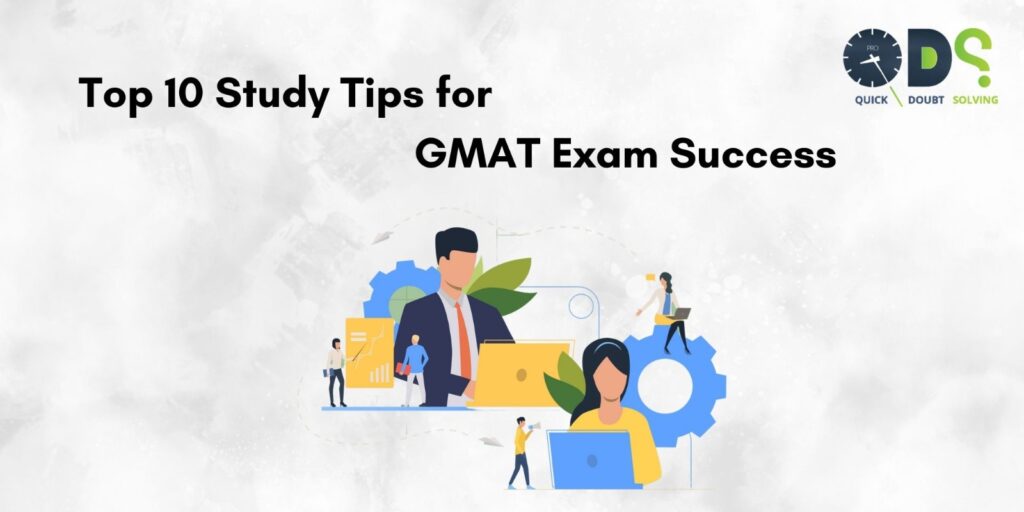
Studying for the GMAT is a crucial factor to take into account when researching the requirements for admission to schools and organizing your application. The GMAT is a test taken by applicants to business schools across the globe who wish to study management. The application procedure is the same for most business schools. In addition to their GMAT results, students must submit an application. A strong GMAT score will help you stand out to potential organizations and improve your chances of being awarded scholarships to help pay for your education. Relax! We at QDS Pro will clear the path for your GMAT success with the correct course, excellent methods and approaches, and a suitable study schedule.
By following these 10 best study tips, you can get closer to your goals of attending business school.
1. Start Early and with a Strategic Mindset:
Many MBA and business master’s programs require essays, letters of recommendation, and resumes; scheduling all of that on top of your GMAT preparation is the last thing you want to do.
Before applying in business school, plan your GMAT study time to avoid situations like this. According to some reports, studying for the GMAT exam only takes eight weeks per person. Consider your areas of weakness and create a study schedule that determines time for every part of the exam.
2. Understand the test portions and evaluate them in your study schedule:
Before you prepare a study plan, it’s important you understand the structure of the GMAT exam. The test consists of four main parts:
- Analytical Writing Assessment (AWA Section) – This test examines your ability to analyze and critique an argument, as well as assesses your writing skills.
- Integrated Reasoning (IR section) – This measures how well you can understand, analyze and interpret data in different formats.
- Quantitative Reasoning (Quant Section) – Examines the ability to think mathematically and logically, solve problems involving numbers, and understand information presented in graphs.
- Verbal Reasoning (Verbal Section) – This test checks your grammar knowledge, evaluates your reading comprehension skills, and identifies any gaps in your understanding of arguments.
To start GMAT preparation, it’s best to begin with a full-length practice test. This will help you get familiar with the different types of questions and experience the time boundaries. This will help you create a study plan that is the opposite of what you currently have.
3. Choose your GMAT preparation materials carefully:
There are many test prep supplies available, but be careful when choosing. Not all of these resources have good content. The GMAT course offered by QDS Pro is considered one of the top resources available. Our course books cover all the basics of the GMAT syllabus in a thorough manner. The books and practice materials provided on the student portal for GMAT preparation have well-researched techniques and strategies. They are better than other resources available for basic GMAT online preparation. The materials include questions and practical examples to help you study.
4. Monitoring your time is a crucial part of GMAT Preparation:
After practicing many tests, it is important to focus on timing during the test. In the verbal section, you have a little over 1.5 minutes for each question. In the Quant section, you have about 2 minutes per question. To balance and manage time effectively, spend less time on the easier concepts that you already know well and allocate more time for the harder questions. Passages take longer to complete because solving the questions requires reading the passage effectively.
Once you have exercised enough and understood the concepts, start keeping track of time so that you can prepare yourself to solve problems more easily. Remember to prioritize both accuracy and completion when taking the test. That means you should manage your time well during the test. Organize and allocate time effectively during the GMAT exam.
5. Apply the method of elimination on the GMAT Exam:
Don’t spend too much time on questions you’re unsure about. When you’re unsure, eliminate the wrong answers to get closer to the right answer. Choose the best option left and proceed to the next question. This is also known as the “guessing strategy”. If you run out of time, even with a good pacing plan, prepare a “guessing method” in advance to avoid losing unnecessary points.
6. Include Mental Math Exercises in Your Study Schedule:
All GMAT exam applicants are good at math and regularly use a calculator. This tool saves time for the Quantitative Reasoning Section. To prepare for this section, practice solving questions mentally since you won’t have a calculator.
7. Push your boundaries with Advanced Questions:
Are you aiming to get into a top MBA or business master’s program? An impressive GMAT exam score can help you strengthen your goals. Setting ambitious goals and maintaining a clear focus on getting into your dream B-School can be a helpful strategy. To improve your skills, it’s helpful to practice challenging questions. The GMAT Official Advanced Questions are a great resource for this. You will also have access to an Online Question Bank that allows you to create customized practice sets. This is a great option for those who want to get a high GMAT score and increase their chances of getting accepted into an MBA or business master’s program.
8. Take Official GMAT Practise Exams:
These practice exams are the most similar to the real GMAT test. Take these tests regularly to track your progress and get comfortable with the testing setup.
9. Examine and Interpret Errors:
After every drill, review your errors and determine why you made them. Using this analytical method, you can prevent repeating the same mistakes on the exam.
10. Put Your Visual Literacy Into Practice:
Managing your time is crucial when it comes to taking tests, as we have already discussed. Want to increase your level of efficiency quickly? Improve your ability to understand symbols, charts, and tables by developing visual literacy skills. The quantitative reasoning section might have symbols you should know. To improve efficiency during the test, focus on mastering the skill of reading and interpreting visual data. This will help you answer questions faster and with greater accuracy.
Conclusion (GMAT Preparation Tips):
In this blog, we’ve discussed preparing for the GMAT exam. We hope you found it easy to understand. To do well on the GMAT exam, you need to be committed, use effective study techniques, and have access to the best preparation materials. The key is to start with a strong base and build on top of it. To learn more about preparing for the GMAT, contact QDS Pro. We are happy to talk to students and help them study for exams. Good luck on your GMAT!



